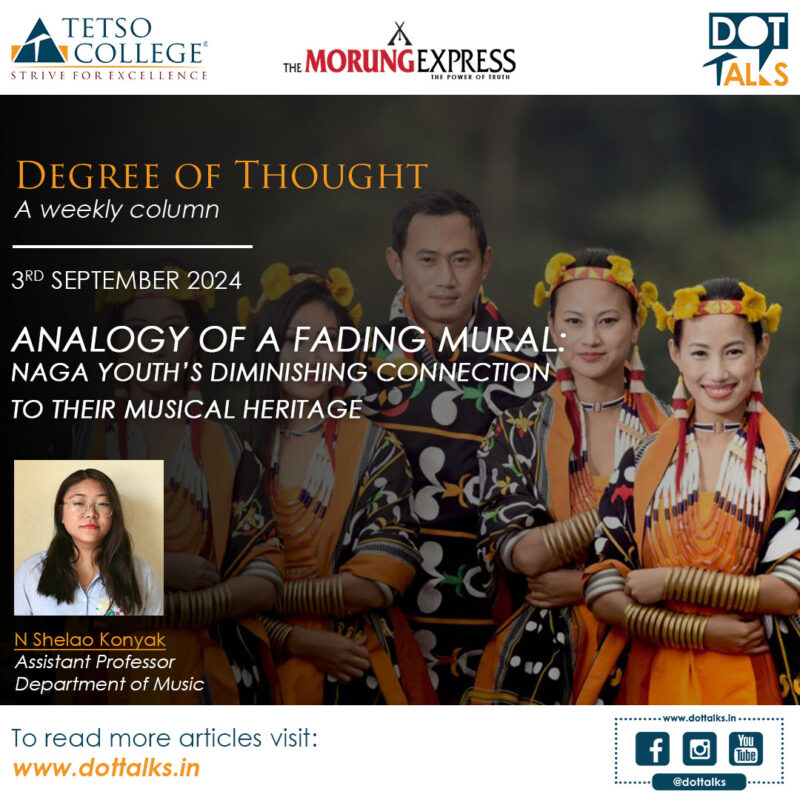Analogy of a Fading Mural: Naga Youth’s Diminishing Connection to Their Musical Heritage
A fading mural refers to a painted or applied artwork on a wall or ceiling that has lost its original vibrancy and detail over time. This can happen due to exposure to the elements, wear and tear, or the natural aging of materials. Figuratively, it symbolizes the declining or loss of significance of something once prominent. It often represents cultural, historical, or artistic elements that are losing their visibility and impact as time passes and new influences emerge.
Thus, in the context of cultural heritage, fading murals refers to the gradual loss of prominence and visibility of traditional cultural practices, much like how a mural on a wall can lose its vibrancy and clarity over time.
Therefore, This analogy highlights how certain aspects of culture, such as Naga’s musical heritage, can become less noticeable or appreciated amongst the Naga youth, as modern influences and new interests tower above.
To begin with, the analogy of the youth’s diminishing connection to Naga’s musical heritage can be equated to a fading mural.
Firstly, Traditional music is like a mural painted with vibrant colors and intricate patterns, representing the rich cultural tapestry of the Naga community. This music, which once formed the backdrop of community life and ceremonies, is slowly becoming less visible as the youth are increasingly drawn to contemporary and globalized forms of entertainment. Just as a mural’s details can become obscured by newer layers of paint, traditional music can be overshadowed by the allure of modern media and pop culture.
Following that, the influx of global media and modern entertainment acts like layers of new paint over the mural. Each new influence adds a layer of complexity, shifting the focus from traditional practices to contemporary trends. While these new influences can bring fresh perspectives and innovations, they also contribute to the gradual erosion of traditional cultural elements, making it harder for the mural’s original details-such as Naga’s musical heritage to be appreciated and preserved.
As the traditional music fades in the background, the vibrant essence of Naga’s musical heritage risks being lost. The energy and cultural significance once embodied in the music are diminished when younger generations prioritize global trends over their own cultural practices. This loss of vibrancy can lead to a weakening of cultural identity and a disconnect from the community’s historical and spiritual roots.
Importantly emphasizing on the fading analogy, efforts must be made to restore the mural to its original brilliance. Thus, this should involve actively promoting and preserving traditional music through education, community initiatives, and cultural celebrations. By engaging youth in these efforts, it is possible to reintroduce the vibrant colors of the mural and ensure that the essence of Naga’s musical heritage remains alive and relevant.
Similarly, just as a restored mural can reclaim its place as a cultural treasure, a renewed focus on Naga’s musical heritage can help the youth rediscover and appreciate the depth of their cultural roots. By integrating traditional music into contemporary contexts and creating new opportunities for engagement, the community can re-energize interest and connection among younger generations.
In conclusion, The analogy of a fading mural rightly captures the essence of the youth’s diminishing connection to Naga’s musical heritage. The challenge lies in addressing the layers of modern influences that obscure traditional practices and in finding ways to restore and preserve the vibrant essence of cultural heritage. Through deliberate efforts to integrate traditional music into contemporary life and foster a renewed appreciation among youth, we can ensure that the Naga’s musical heritage remains a vibrant and cherished part of our Naga cultural identity.
Degree of Thought is a weekly community column initiated by Tetso College in partnership with The Morung Express. Degree of Thought will delve into the social, cultural, political and educational issues around us. The views expressed here do not reflect the opinion of the institution. Tetso College is a NAAC Accredited UGC recognised Commerce and Arts College. The editorial team includes Chubamenla, Asst. Professor, Dept. of English and Rinsit Sareo, Asst. Manager, IT, Media & Communications.
For feedback or comments please email: dot@tetsocollege.org


